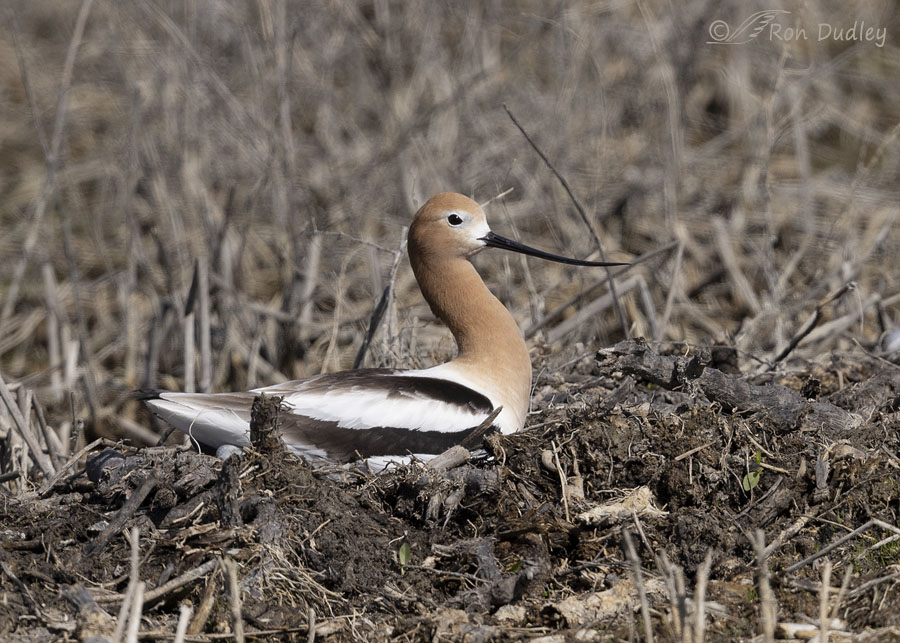Two days ago on a heavily overcast morning I spent some time with an obviously mated pair of American Avocets at Bear River MBR. At first they were both foraging for food in a flooded area that had been burned last fall for phragmites control. Initially I had no idea that their nest was nearby.

But it was. After a while the male walked away from the water and began to meticulously inspect their nest with his bill. It may not look like much of a nest but that’s what it is.

Soon his smaller mate joined him at their nest.
While building their nest both sexes collect lining material from near the nest and toss it over their backs toward the nest. For a few seconds both of these birds were doing exactly that but they always had their backs to me and they did it half-heartedly, so I had the definite impression that that portion of their nest-building routine was essentially complete.
Eventually both birds walked back to the water and began foraging again. At one point one of them took off and…

circled around, only to come right back and join its mate again. I find avocets to be a difficult subject to photograph well in flight so I was happy to get this shot, even though the bird is fairly small in the frame.
At that point the avocets weren’t doing anything but feeding so I drove on to look for other birds. Because of the mostly poor light it was my intention to head for home when I reached the end of the auto tour loop.
But when I got there I could see that the clouds were clearing so I decided to drive the loop again. Part of my motivation was to check on the avocets one more time. Perhaps they’d be doing something interesting related to nesting activities.

But when I got there they were both still foraging for food. In the beginning this was the only interesting shot I got, taken as the avocet performed a one-footed wing stretch.

But soon the male (I believe) walked over to the nest again and this time he sat down in the nest as if he were incubating. And maybe he was because in this species both sexes incubate. He stayed in the nest for a long time so eventually I left the avocets and drove on down the road.
If there were any eggs in the nest I probably wouldn’t have been able to see them at the angle I was forced to shoot from. Avocet clutch size is usually four eggs and it typically takes the female five days to lay all four so I have no idea what stage the avocets may be in in the egg-laying process.
But if their nest isn’t flooded during spring runoff (a definite possibility), I have hopes of photographing puffball baby avocets in a few weeks.
Ron
Note: A half hour after I published today’s post, WordPress still hasn’t sent out the email containing a link to the post to subscribers. Apparently there’s a glitch in the system. C’mon WordPress, wake up.
OK, they finally sent it out at 6:29 AM Mountain Time. As they say, better late than never.


Keeping my fingers crossed for this pair and their offspring. I hope that the runoff leaves them alone. The weather continues to be weird. After summer temps in the 90s last week, we’re back to cooler weather with rain (and snow in the mountains) forecast for Thursday.
Marty, we get the leftovers of your weather roller coasters. Been hot here but it’s supposed to begin cooling off significantly beginning tomorrow.
Such an elegant bird – and such an unlikely looking nest. What predators to the pufffballs (and I hope to see photos of them) face in such an unprotected haven?
EC, when very young they have a variety of potential predators including harriers and other raptors, ravens, weasels, coyotes and others. They’re precocial so the leave the nest almost immediately so the danger won’t be restricted to the immediate area of the nest.
Thank you. I do love starting my day learning…
Very interesting post. Yes, if the increase in water and flooding doesn’t take the nest. I saw a few nesting sites in similar areas and the water is tuning the nest into an island.
April, all the water this year is a two-edged sword.
Ron, all these water birds you have been showing us recently are SO fascinating. Except for pictures, I don’t think I have ever seen a willet or curlew or avocet. They are all lovely, but these avocets are particularly so – their colors and curves, just peace-making. And their species name just adds to it! Thank you for showing a whole new world. Hopefully their nest will survive.
I’m glad your enjoying the “water bird” photos, Carolyn. Tis the season for them, around here at least.
Looking forward to the little puff ball Avocets. If you get them that would be a real treat. Always look forward to their arrival.
Pics of the babies may be a long shot but it could happen, Everett. I sure hope it does.
Always one of my favorites and a most elegant looking species. There is always some curiosity about the bill. They feed by sweeping through shallow water. Nerve endings for touch along the bill’s margin allow detection of possible prey when encountered. An upturned bill may make it easier to forage for prey at the same depth rather than a range of depths like a straight bill would offer when stuck into the water. They feed in shallow ponds and male forage a bit deeper than females (but much overlap). The female bill is shorter and more sharply upcurved. In the 1500s the more upturned bill (Asian and European species) was thought by some to be older birds whose bills had become bent from probing. Of course, we know today that the bill doesn’t change shape and they don’t probe
Dan, interesting to learn about the theories attempting to explain the shape of their bill. Both the current one and the historical one were new to me.
Thank you Dan. I find your additions to Ron’s posts to be completely fascinating.
Thank you, Dan. I always enjoy your informative comments!
Beautiful poses of a most elegant bird. Even the legs are gorgeous. The name is elegant, as well. At least the common one. And easier to pronounce.
Thanks, Lyle. For some reason I like their species name – recurvirostra.
Love the photos! Gorgeous birds! I hope you get to photograph the baby puffballs because I’d love to see them. Thanks for sharing all your work!
I hope so too, Joanne. Thanks.
I love these birds, they are so unique looking. Don’t get much of a chance to see them here in SC. I have a picture from a calendar of an avocet pair up in my classroom. One of my students (10 years old) said they look like toasted marshmallows. Think he nailed it- I will always only think of them as this when I describe them.
Toasted marshmallows – that’s a pretty good description of them, Marcia. White and brown and black.
Nice! One certainly wouldn’t spot that nest if not for the birds! Beautiful in their breeding plumage. Luv the “stretch” and flite shots – have never seen them other that working a “prairie pothole” for as long as they last……
“One certainly wouldn’t spot that nest if not for the birds.”
That’s for sure, Judy. Not a chance.
Sensational seroes Ron!
Charlotte Norton
Thanks, Charlotte.
The American Avocet is a lovely bird. The photo of the pair may be simple, but it is quite beautiful.
Always appreciate your narratives; they never fail to inform.
“Always appreciate your narratives; they never fail to inform”
Very good to know. Thank you, Michael.
Agree – the photo of the pair is magical. Somehow they look earnest and slightly anxious?. Perhaps its partly the postures of the two of them and both with an upward curved bill – a tentative trusting smile? Anthropomorphism is thriving today in Boston.
Nothing wrong with a little anthropomorphism, Frances.
Loved seeing these very elegant birds–until now, I was totally unfamiliar with
them. I’m intrigued by their upwardly-curved beaks which look as if they’re
adapted for specific function. Do they use them to root around subsurface of soil/sand for their food ?
Kris, they usually forage in shallow water. I’m not sure of the functionality of the curved bill, except to provide their species name – :”recurvirostra”.